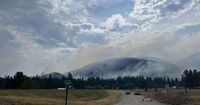As the calendar turned to September 2025, Washington state found itself in the grip of a fierce wildfire season, with 14 separate blazes burning across the region and leaving a thick haze over cities from Seattle to Yakima. Residents awoke to smoky skies, orange sunsets, and air quality warnings that have become all too familiar in recent years.
According to KIRO7 News, the air quality index (AQI) on Sunday, September 7, was rated as "moderate" in Seattle, Bellevue, and the Kent Valley. But for communities further inland, the news was far more troubling. Wenatchee, Moses Lake, and Yakima faced air deemed "unhealthy for sensitive groups," while Colville's AQI was simply classified as "unhealthy." It was a sobering reminder of the reach and impact of these wildfires—not just for those in the immediate path of the flames, but for millions breathing the smoky air across the state.
The fires themselves varied in size and ferocity. The largest included the Bear Gulch Fire, which had scorched 10,000 acres near Lake Cushman in the Olympic National Forest and was only 9% contained as of September 7. The Lower Sugarloaf Fire, burning east of Lake Wenatchee, also reached 10,000 acres. The Rattlesnake Fire, near the Lake Roosevelt National Recreation Area, had grown to 13,000 acres, while the Crown Creek Fire was the biggest of all, charring 14,000 acres along the upper Columbia River, east of the Colville National Forest—and sitting at just 5% containment.
But it was the Crown Creek Fire, and its eventual merger with the Blackhawk Mountain Fire, that captured the region’s attention and concern. According to the U.S. Forest Service, by September 7, these two fires had combined to burn 13,941 acres, with over 800 personnel, 79 engines, and 15 crews deployed in an all-out effort to contain them. The Tacoma Creek Fire, meanwhile, continued to threaten Stevens and Pend Oreille counties in tandem with Crown Creek, compounding the challenge for fire crews already stretched thin.
“Cooler temperatures and moisture this week will help moderate fire behavior,” authorities said in a statement on September 7, offering a glimmer of hope after days of relentless expansion. Yet, for many, the danger was far from over. On September 4, Stevens County Emergency Management expanded the Level 3 "GO NOW" evacuation alert area for the Crown Creek Fire, pushing it further south of Peterson Swamp Road and Randall. Residents in the fire’s path were urged to be ready for sudden evacuation changes at a moment’s notice.
Lightning was the culprit for several of these blazes. The Crown Creek, Blackhawk Mountain, and Katy Creek Fires were all sparked by lightning strikes, with the Blackhawk Mountain Fire burning 825 acres at 0% containment and the Katy Creek Fire reaching 1,329 acres. As of early September, an estimated 125 structures and 170 people were threatened or directly impacted, with the potential for more as winds shifted and flames advanced.
According to Northeast Washington Fire Information, the Crown Creek Fire’s explosive growth was evident in the first days of September. On September 1, it had already surpassed 3,100 acres, while the Blackhawk Mountain Fire was burning 372 acres. Emergency shelters, such as the one opened by the American Red Cross in Stevens County, became lifelines for displaced residents, providing food, shelter, and a sense of community amid the chaos. Officials urged those evacuating to bring prescription medications, extra clothing, and vital documents, underscoring the seriousness of the situation.
Firefighting efforts were hampered by more than just the flames. Smoke and low visibility grounded helicopters and aircraft, especially in areas like North Cascades National Park, where the Perry Fire forced the closure of several trails and camps. Fire suppression teams on the ground faced steep, rugged terrain, making progress slow and dangerous. “Fire crews on the ground are working to contain the fire, but are being hampered by extremely steep, difficult and rugged terrain,” North Cascades National Park public affairs officials explained, highlighting the physical and logistical barriers facing responders.
Other significant fires included the Wildcat Fire, burning 7,500 acres east of Mount Rainier near Bumping Lake, and the Labor Mountain Fire, which had nearly reached 2,000 acres north of Cle Elum. The Pomas Fire west of Lake Chelan, the Lynx Mountain Fire near the Colville Reservation, and the Tacoma Creek Fire—all ranging between 2,700 and 3,500 acres—rounded out the list of major blazes. While some fires were just a few hundred acres, the larger ones demanded the bulk of firefighting resources and public attention.
The threat to property and life was real and immediate. On August 31, Level 1, 2, and 3 evacuations were in effect for communities like Marble and Onion Creek, with the Crown Creek Fire already over 1,000 acres and 0% contained. Helicopters and smoke jumpers were deployed, and the Washington State Fire Marshal’s Office mobilized additional resources as the fire’s rapid growth pushed evacuation orders further afield. By September 3, the Crown Creek Fire had expanded significantly on its east and south sides, prompting officials to remind residents to stay alert and prepared for possible evacuation changes.
Despite the dire circumstances, there were signs of resilience and hope. Over 800 personnel labored day and night to check the fires’ advance, and the promise of cooler, wetter weather held the potential to ease fire behavior in the coming days. Yet, as history has shown, wildfires in the Pacific Northwest are as unpredictable as they are destructive. A red flag warning remained in effect until 9 p.m. on September 4, underscoring the ongoing dangers posed by dry conditions and shifting winds.
For Washingtonians, the 2025 wildfire season was a stark reminder of the challenges posed by a warming climate, dense forests, and the ever-present risk of lightning storms. It was also a testament to the courage and determination of firefighters, emergency workers, and communities banding together in the face of adversity. As the smoke slowly began to lift and air quality showed tentative signs of improvement, the people of Washington looked to the horizon—hoping for clearer skies and a return to normal, but always ready to respond should the fires flare up once more.




